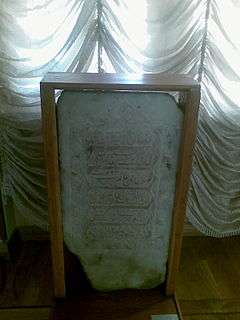Panah Ali Khan

Panah-Ali Khan Javanshir (Azerbaijani: Pənah Əli Qarabağlı) (1693, Sarijali, Azerbaijan – 1761, Shiraz, Iran) was the founder and first ruler of Karabakh Khanate under Persian suzerainty.[1][2]
Origins and early life
Panah Ali Khan was from the Sarijali branch of the clan of Javanshir, who with their associate clan of Otuz-Iki (meaning thirty-two in Azerbaijani) had for long been rivals of the Yirmi-Dört (meaning twenty-four in Azerbaijani) and Ziyadoglu Qajars of Ganja, whose chiefs had been official rulers of Karabakh since Safavid times.[3]
Panah Ali's paternal great grandfather and namesake Panah Ali bey served at the court of Ganja beylerbeys (governors) in the early 17th century, at the time when the region's was directly controlled by the Safavid Empire of Iran. He soon retired, married a woman from the Javanshir clan of Karabakh and had a son by the name of Ali (nicknamed Sarija Ali). They lived in their estate located in Arasbar (Arasbaran) (present-day Khojavend and Agdam rayons of Azerbaijan) but also owned land in Tartar and the northern shores of the Aras River. The Arasbar estate was rebuilt into a castle in Sarija Ali's son Ibrahim Khalil's lifetime and has been known as Ibrahim Khalil Galasi since.[4]
After the dethronement of the Safavids in 1736 by Nader Shah, the landed classes of Ganja and Karabakh gathered in Mugan (the Javanshirs were also among them) deciding to oppose the new shah and agreeing on trying to get the Safavids back on the throne. When this news reached Nader Shah, he ordered all Muslim landowners of the region and their families deported to Khorasan (northeastern Iran) as a punishment. As such, Panah Ali happened to be among the deportees.[4]
In 1747, Panah Ali, by then already a successful naib and royal gérant de maison, found himself displeased with Nader Shah's attitude towards him and having gathered many of those deported from Karabakh in 1736, returned to his homeland. Due to his reputation as a skillful warrior and his wealthy ancestor's legacy in Karabakh, Panah Ali proclaimed himself and was soon recognized throughout most of the region as a ruler (khan). The shah sent troops to bring back the runaway however the order was never fulfilled: Nader Shah himself was killed in Khorasan in June of the same year. The new ruler of Persia, Adil Shah issued a firman (decree) recognizing Panah Ali as the Khan of Karabakh.[4]
Karabakh Khanate
The capital of the khanate was moved three times to strengthen the Panah Ali's power in the Karabakh. The Bayat fortress, built in 1748, was the khan first residence. "In a short period of time, external walls were constructed, ditches were dug out, and the bazaar, the bath and the mosque were build." Craftsmen from surrounding areas were re-settled into the castle. "Many of residents of the area and even residents, especially craftsmen, of the Tabriz district and Ardabil, moved into the Bayat castle with their families, having heard about Panah Ali Khan's success, governance and mercy."[5]
Strengthening of Panah Ali khan's power faced resistance from other khans (e.g. Khan of Ganca, Khan of Shaki) and from meliks of Nagorno-Karabakh. The struggle between the Karabakh khan and Haji Chalabi Khan of Shaki, one of the most powerful feudal rulers of the South Caucasus, started in 1748. Haji Chalabi Khan wishing Panah Ali khan's power not increased further, allied with the Khan of Shirvan and surrounded the castle of Bayat. The allies for the whole month unsuccessfully tried to capture the capital of the Karabakh khanate. The Shaki and Shirvan khans withdrew, incurring huge casualties and failing to accomplish the mission. Haji Chelebi Khan was forced to admit: "Until now Panah Khan was raw silver that was not minted. We came, minted it, and returned." [4] Same quote from another Karabakh historian of 19th century, Mirza Yusif, reads: "Until now Panah Khan was merely gold, we came and minted a coin from that gold."[6]
Death
When Karīm Khan Zand took control of much of Iran, he forced Panāh Khan to come to Shiraz (Capital), where he died as a hostage.[7] Panah-Ali Khan's son Ibrahim-Khalil Khan was sent back to Karabakh as governor.[3] Ibrahim, succeeding his father (1760), not only ruled over most of Qarābāḡ, but also became one of the major potentates in the Caucasus.
See also
References
- ↑ "History of Azerbaijan" Encyclopædia Britannica Online:
- ↑ Abbas-gulu Aga Bakikhanov. Golestan-i Iram
- 1 2 Tapper, Richard (1997). Frontier Nomads of Iran: A Political and Social History of the Shahsevan. Cambridge University Press. p. 114. ISBN 0-521-47340-3.
- 1 2 3 4 Mirza Adigozel-bek, Karabakh-name (1845), Baku, 1950, p. 54
- ↑ Mirza Jamal Javanshir (1847), History of Karabakh, Baku, 1959, p. 68
- ↑ Mirza Yusuf, Tarihi-Safi, 1856
- ↑ BOURNOUTIAN, GEORGE. "EBRAHÈM KHALÈL KHAN JAVANSHER". Encyclopedia Iranica. Retrieved 2011-11-04.